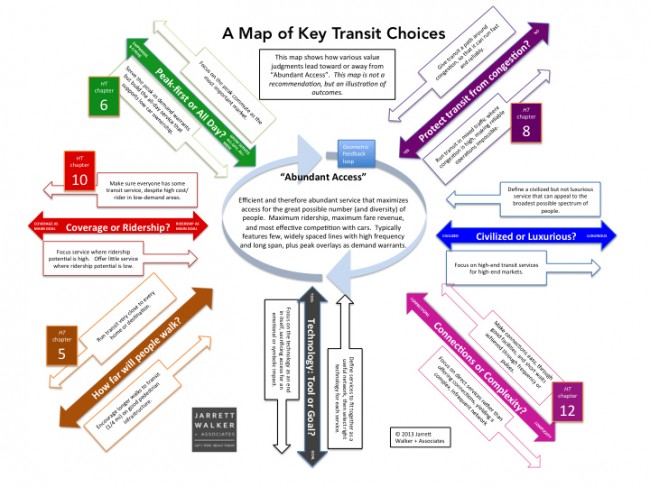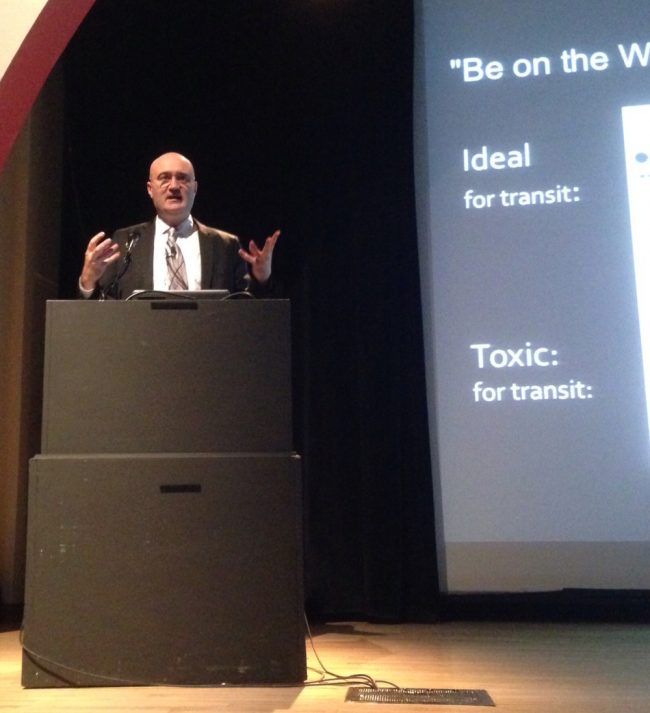
We are celebrating 15 years — and counting — of stories that are deeply researched and deeply felt, that build a historical record of what the city has been.
We are celebrating 15 years — and counting — of stories that are deeply researched and deeply felt, that build a historical record of what the city has been.
Two things are for certain: New Yorkers know their public transportation and they have strong feelings about it. Overheard one rush hour morning commute, two subway riders, strangers before being squeezed together at the Lorimer stop, rated subway lines as if they were Straphangers Campaign staff. The 1 and the 6: the worst; the 7: quite good.
But what is it exactly that makes public transportation successful? This is something that most New Yorkers cannot tell you.
But Jarrett Walker can. Walker is the President of Jarrett Walker + Associates, writer of the transit blog HumanTransit.org, and author of Human Transit: How Clearer Thinking about Public Transit Can Enrich Our Communities and Our Lives. On a Thursday evening in February, Walker stopped by Parsons The New School for Design to speak about transit and urban design. Walker was in town to teach a two-day class on transit network design. The course, which drew professionals from multiple states and countries, was sponsored by the Transit Center.

A transit network workshop team at work | Image courtesy of the Transit Center
Walker began his talk, entitled “Abundant Access: Public Transit as an Instrument of Freedom,” with the observation that people often find it difficult to pinpoint transit’s purpose. It seems people want to talk around transit: it’s an economic development tool for a neighborhood or a municipality; it helps the environment; by taking cars off the road, it helps traffic flow. However, according to Walker, the answer is simple: the purpose of transit is to provide abundant access.
Delving a bit deeper: transit grants individuals personal freedom — the opportunity to go where you want, when you want. Providing people with “abundant access” means that they can reach more destinations, with greater speed. People have more choices and, therefore, more freedom.
What goes into abundant access? In addition to walking, biking, and driving, there must be a network of public transit routes or lines designed to optimize frequency, span, speed, reliability, and capacity. Walker pointed out that people tend to over-value speed and under-value frequency. Despite this, when planning for transit, we must be always conscious of frequency. There are people who will see that a bus will come in 30 minutes and they’ll go and get a beer while they wait. And there are people who need a bus to come every seven minutes so they can get to work on time.

A Map of Key Transit Choices leading to Abundant Access | Image via Human Transit
Many factors get in the way of achieving progress on Walker’s terms. Bringing the conversation back to urban design, he noted that a number of common design elements undermine abundant access, such as “transit unconscious development” and the one-way loop. Walker added that the emphasis many designers give to prioritizing certain modes of transit over others is counter-productive.
Walker defined transit unconscious development as development that incorporates transit but fails to optimize it. Transit works best when moving along a straight line, so running bus lines to cul de sac developments, or off a straight road to a college on a hill, is harmful to transit’s effectiveness. The flip side of this is that suburban boulevards — straight and fast-moving — are great streets for transit. Furthermore, Walker noted, in order for transit to be successful, streets don’t have to be beautiful. Plantings, colorful pavers, and other streetscape improvements are unnecessary; just make sure there are safe places for people to cross the street every quarter mile.
Another design element that lessens abundant access is the one-way loop transit system. According to Walker, a one-way loop is a terrible idea. After all, “who wants to ride around in a circle?”
Walker maintained that for the most part, transit technology — the buses vs. subways or buses vs. trolleys debates — does not matter. “People who ride trams aren’t ‘tram riders,’” he counseled the audience; it’s most likely they want to go where the tram goes. Technology does matter at extremes, however; if you need 300-person capacity, you need a long bus, not a trolley. “To anyone who thinks his freedom depends on one kind of vehicle, isn’t he just choosing symbols?” Walker questioned.

Jarrett Walker | Image courtesy of the Transit Center
Walker did not allow his talk to become mired in the tangle of entrenched realities facing transit in New York City. He did not talk about the challenges of planning, implementing, and running public transportation systems: the huge expenses, the lack of funding for operations, the separate pots of federal funds (when federal funds are available at all) that dictate the kinds of transit investment possible, aspects of the public process, and the legal challenges that can severely curtail the scope of projects. For those who spend their days navigating the public transit world as I do, his omissions were refreshing. While he spoke, thoughts of how transit should be emerged unencumbered by thoughts of how it is.
But Walker did chide New York by unfavorably comparing what he termed “New York’s bus lane quarrels” — the City’s roll-out of six Select Bus Service (SBS) routes during the Bloomberg administration — to Paris’s decision to have a dedicated bus lane on every boulevard. Throughout the talk, it was impossible not to think about the challenges facing public transportation within the city, beyond its borders, and in the nation as a whole.
While New York’s SBS routes are lacking key Bus Rapid Transit elements that would do much to improve service, the SBS lines have been successful, at least in terms of the reported “person hours saved.” And, Mayor de Blasio has pledged support for a more extensive SBS network. For all the strangers squeezed next to each other on our subways and buses, here’s hoping.
The views expressed here are those of the authors only and do not reflect the position of The Architectural League of New York.